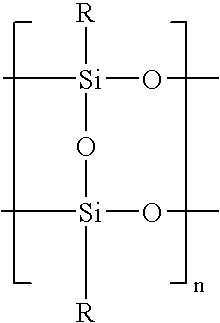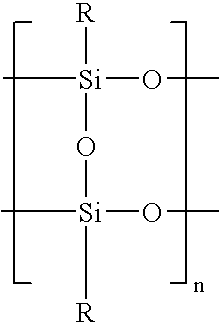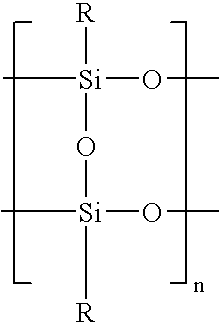However, many
chemical species are neither thermally stable enough, nor volatile enough, for sustained
vaporization, delivery and deposition.
As a consequence, CVD processes for film deposition are largely limited by the availability of volatile and stable precursors as source reagents.
PVD, utilizing a charged gas and a sputter target to effect deposition of material on a substrate, is well-developed and widely used in the art, but is limited by the significant particle levels that are generated in the process, as well as by constraints on
controllability and conformality of the
deposition process when tight geometries and small features are involved, and by
process control issues relating to
diffusion of the sputtered material.
Due to the ballistic nature of sputtered materials, it is extremely difficult to achieve conformal coverage on
complex topography of next generation patterned substrates.
Physical vapor deposition is currently a preferred technique for depositing high purity
metal films, but conventional PVD methods tend to produce thin bottom-corner coverage in deep vias or trenches, thereby producing a potential weak point for barrier performance.
Since aspect ratios are a critical factor in evolving device microstructures, it is likely that in the very near future the PVD technique will not be able to provide sufficient step coverage to deposit the
diffusion barrier at the required thickness at all points within the high
aspect ratio via.
Although many of such processes are extremely well-developed for advanced microelectronic device manufacture, the application of these processes for high
aspect ratio via filling is burdened by difficulties.
For deposition of conducting materials such as
copper, CVD processes therefore can only compete with
electroplating techniques (aqueous based processes) when the
cost of ownership (COO) for the process is small.
Additionally,
copper diffuses readily into oxides and dielectrics, causing line-to-line leakage.
Moreover, the
copper can readily react with
silicon at temperatures below 200.degree. C., causing detrimental effects that can ultimately lead to
device failure.
Further, the
dielectric constant of the low k material is critical and aqueous
contamination can negatively increase
dielectric constants, which is largely unacceptable.
With decreasing feature size and increasing
aspect ratio, the use of PVD to obtain the required seed
layers becomes a major technical challenge.
Alkyl siloxanes and cyclosiloxanes such as TMCTS (tetramethylcyclotetrasiloxane) and OMCTS (
octamethylcyclotetrasiloxane) are promising precursors for deposition of such films, but are susceptible to the presence of
trace amounts of impurities that can lead to undesirable cationic or anionic
polymerization.
Unfortunately, there are few known materials with
dielectric constants this low, and none of such known materials is compatible with semiconductor manufacturing requirements.
The utilization of porous insulator polymeric materials, however, introduces a new and unique set of integration issues.
The deficiencies of CVD-grown low k polymeric materials include premature degradation and / or
polymerization of the precursors in delivery lines caused by the high temperatures typically employed, as discussed hereinabove, with the potential for catastrophic consequences within the
processing tool.
However, thin films of controlled
stoichiometry are somewhat difficult to fabricate.
For example, it is very difficult to deposit a PZT film directly on an
Si substrate because Pb is highly reactive with Si and easily diffuses into the
Si substrate.
This leads to an increase in complexity of the overall process as well as an increase in cost.
PVD methods, however, have the associated disadvantages of physical damage to the dielectric during
sputtering of the
metal films and
metal diffusion through the dielectric material in the device structure.
 Login to View More
Login to View More 


